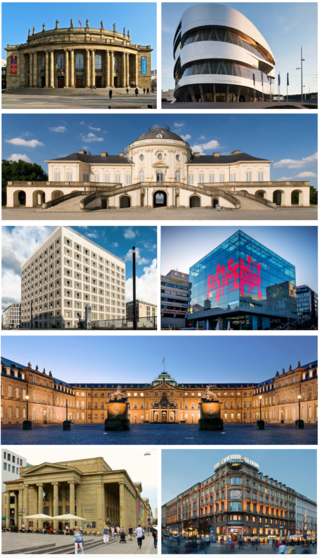
Stuttgart is the capital and largest city of the German state of Baden-Württemberg. It is located on the Neckar river in a fertile valley known as the Stuttgarter Kessel and lies an hour from the Swabian Jura and the Black Forest. Stuttgart has a population of 635,911, making it the sixth largest city in Germany, while over 2.8 million people live in the city's administrative region and nearly 5.5 million people in its metropolitan area, making it the fourth largest metropolitan area in Germany. The city and metropolitan area are consistently ranked among the top 20 European metropolitan areas by GDP; Mercer listed Stuttgart as 21st on its 2015 list of cities by quality of living; innovation agency 2thinknow ranked the city 24th globally out of 442 cities in its Innovation Cities Index; and the Globalization and World Cities Research Network ranked the city as a Beta-status global city in their 2020 survey. Stuttgart was one of the host cities for the official tournaments of the 1974 and 2006 FIFA World Cups.

Baden-Württemberg, commonly shortened to BW or BaWü, is a German state in Southwest Germany, east of the Rhine, which forms the southern part of Germany's western border with France. With more than 11.07 million inhabitants as of 2019 across a total area of nearly 35,752 km2 (13,804 sq mi), it is the third-largest German state by both area and population. As a federated state, Baden-Württemberg is a partly-sovereign parliamentary republic. The largest city in Baden-Württemberg is the state capital of Stuttgart, followed by Mannheim and Karlsruhe. Other major cities are Freiburg im Breisgau, Heidelberg, Heilbronn, Pforzheim, Reutlingen, Tübingen, and Ulm.

The Neckar is a 362-kilometre-long (225 mi) river in Germany, mainly flowing through the southwestern state of Baden-Württemberg, with a short section through Hesse. The Neckar is a major right tributary of the Rhine. Rising in the Schwarzwald-Baar-Kreis near Schwenningen in the Schwenninger Moos conservation area at a height of 706 m (2,316 ft) above sea level, it passes through Rottweil, Rottenburg am Neckar, Kilchberg, Tübingen, Wernau, Nürtingen, Plochingen, Esslingen, Stuttgart, Ludwigsburg, Marbach, Heilbronn and Heidelberg, before discharging on average 145 m3/s (5,100 cu ft/s) of water into the Rhine at Mannheim, at 95 m (312 ft) above sea level, making the Neckar its 4th largest tributary, and the 10th largest river in Germany. Since 1968, the Neckar has been navigable for cargo ships via 27 locks for about 200 kilometres (120 mi) upstream from Mannheim to the river port of Plochingen, at the confluence with the Fils.

Stuttgart Airport is the international airport of Stuttgart, the capital of the German state of Baden-Württemberg. It is christened in honor of Stuttgart's former mayor, Manfred Rommel, son of Erwin Rommel, and is the sixth busiest airport in Germany with 11,832,634 passengers having passed through its doors in 2018.
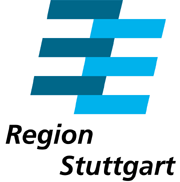
Stuttgart Region is an urban agglomeration at the heart of the Stuttgart Metropolitan Region. It consists of the city of Stuttgart and the surrounding districts of Ludwigsburg, Esslingen, Böblingen, Rems-Murr and Göppingen. About 2.7 million inhabitants live in that area (3,700 km2). In fact, with 708 people per square kilometre, the Stuttgart Region is one of the most densely populated areas in Germany. Stuttgart Region is governed by a directly elected parliament.

Bad Cannstatt, also called Cannstatt or Kannstadt, is one of the outer stadtbezirke, or city boroughs, of Stuttgart in Baden-Württemberg, Germany. Bad Cannstatt is the oldest and most populous of Stuttgart's boroughs, and one of the most historically significant towns in the area of Stuttgart. The town is home to the Cannstatter Wasen and Cannstatter Volksfest beer festivals, the MHPArena, the Hanns-Martin-Schleyer-Halle, and the Porsche-Arena.

Zuffenhausen is one of three northernmost boroughs of the city of Stuttgart, capital of the German state of Baden-Württemberg. The borough is primarily an incorporation of the formerly independent townships Zuffenhausen, Zazenhausen, Neuwirtshaus, and Rot, the latter is a historic town that gained importance in 1945 as a refugee camp for German refugees. As of 2009 around 35,000 people lived in Zuffenhausen's area of 1,200 ha (12 km2), making it the third largest of Stuttgart's outer boroughs. Zuffenhausen is also one of the oldest continuously inhabited places in Stuttgart with evidence of permanent settlements that can be traced back 7,500 years.

Stuttgart Hauptbahnhof is the primary railway station in the city of Stuttgart, the state capital of Baden-Württemberg, in southwestern Germany. It is the largest regional and long-distance railway station in Stuttgart, the main node of the Stuttgart S-Bahn network, and, together with the station at Charlottenplatz, it is the main node of the Stuttgart Stadtbahn.

Köngen is a municipality in the district of Esslingen in Baden-Württemberg in Germany. About nine kilometers from the district city Esslingen am Neckar and about six kilometers away from Nürtingen. It is part of the Stuttgart Region and the European Stuttgart Metropolitan Region.

The Royal Württemberg State Railways were the state railways of the Kingdom of Württemberg between 1843 and 1920. Please see also the main article History of the railway in Württemberg.

The history of railways in Württemberg describes the beginnings and expansion of rail transport in Württemberg from the first studies in 1834 to today.
The Stuttgart-Bad Cannstatt–Aalen railway, also known as the Remsbahn or the Remstalbahn, was historically the main line route from Stuttgart-Bad Cannstatt via Aalen to Nördlingen. Today the designation Rems Railway only refers to the section from Stuttgart to Aalen, the Aalen–Nördlingen line becoming part of the Ries Railway (Riesbahn). Between Waiblingen and Essingen the Rems line runs parallel to the River Rems from which it gets its name. The Deutsche Bahn timetable incorporates the Stuttgart–Aalen section as part of route no. 786 Stuttgart–Aalen–Crailsheim–Nuremberg and the Stuttgart–Schorndorf section as part of route no. 790.2-3.

Zuffenhausen station is a railway station of the Stuttgart S-Bahn in Zuffenhausen in the city of Stuttgart, in the German state of Baden-Württemberg. With its six platform tracks, it is one of the largest stations in Stuttgart.

Esslingen (Neckar) station is the most important station in the town of Esslingen am Neckar in the German state of Baden-Württemberg and is located 13.2 kilometres (8.2 mi) from Stuttgart Hauptbahnhof on the Fils Valley Railway.
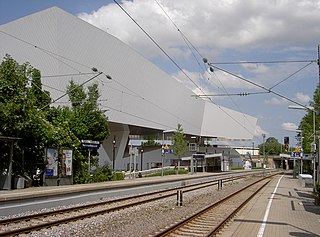
Neuwirtshaus (Porscheplatz) station is on the Stuttgart S-Bahn in the Stuttgart district of Zuffenhausen in the German state of Baden-Württemberg.
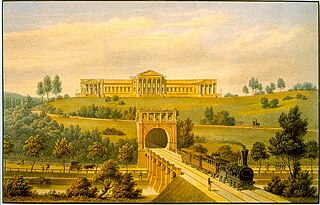
The Rosenstein tunnel is the name of several past, present and planned tunnels in the Stuttgart metropolitan area, in the German state of Baden-Württemberg. Today it is a railway tunnel under Rosenstein Park to Bad Cannstatt. It now connects the Fils Valley Railway (Filstalbahn) from Stuttgart Central Station (Hauptbahnhof) to the Rosenstein Bridge over the Neckar to Bad Cannstatt station.
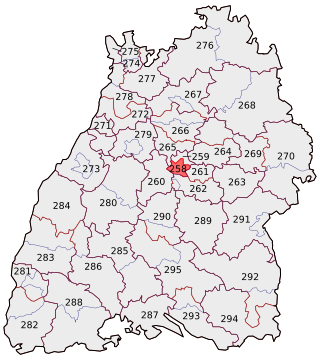
Stuttgart I is an electoral constituency represented in the Bundestag. It elects one member via first-past-the-post voting. Under the current constituency numbering system, it is designated as constituency 258. It is located in central Baden-Württemberg, comprising the central and southern part of the city of Stuttgart.
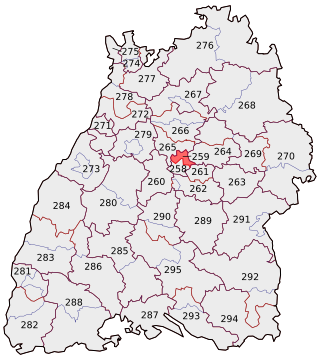
Stuttgart 2 is an electoral constituency represented in the Bundestag. It elects one member via first-past-the-post voting. Under the current constituency numbering system, it is designated as constituency 259. It is located in central Baden-Württemberg, comprising the northern part of the city of Stuttgart.
The following is a timeline of the history of the city of Stuttgart, Germany.
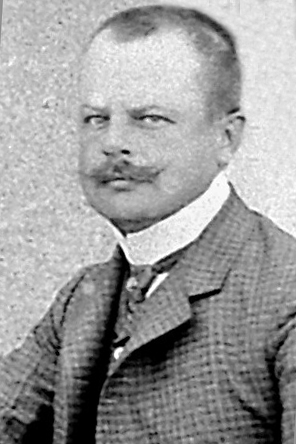
Adolf Daimler was the son of German inventor and industrialist Gottlieb Daimler. A mechanical engineer by training, Adolf became managing director and co-owner of his father's firm Daimler-Motoren-Gesellschaft in 1900. Along with his brother Paul Daimler, Adolf is credited with developing the distinctive Mercedes 3-pointed star logo.




















